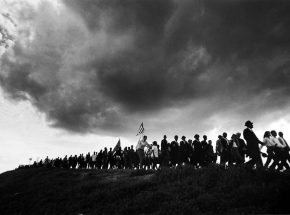

Drawn to international areas ripe with social and political strife, Karales was committed to capturing the concerns of the human spirit. In his powerful photographic essays made for Look magazine Karales managed to combine his creative vision and documentary intuition to create classically rendered compositions.
In 1955 James Karales, having just graduated from Ohio University with a B.F.A. in photography, walked into the office of the Magnum photo agency looking for work. John Morris, the editorial director, hired Karales as an assistant to the photographer W. Eugene Smith to help print his photographs. After two years working with Smith Karales was inspired to pursue his own photographic career and set out to document life in Rendville, Ohio. The old mining town, once a stop on the underground railroad, held particular interest for Karales’ documentary purposes because it was one of the few integrated working communities in the country and had attracted many Southern blacks for its mining industries that offered rare employment opportunities. Karales returned to New York whereupon he showed his photographs of Rendville to Edward Steichen at the Museum of Modern Art who purchased two photographs for the collection. In 1958 this ambitious independent essay was exhibited in New York City’s legendary Limelight Gallery. Later the same essay caught the eye of a Look magazine photo editor who hired him in 1960 as a staff photographer.
As a photojournalist in the sixties James Karales found himself in a country on the verge of revolution at home and war abroad. In 1962 Karales began his landmark essay following the civil rights leader Martin Luther King in his crusade across the segregated south. In 1965 Karales photographed the famous Freedom March from Selma to Montgomery creating one of the great iconic images of the century – an dramatic scene of brave marchers with American flags walking over a stormy hill crest. That same year Karales took off to Vietnam to photograph U.S. Special Forces maneuvering in the jungle. For the next three years he alternated between trips to Vietnam and the civil rights frontier producing some the most memorable and dynamic photographs from that period.
Look magazine folded in 1972 after which Karales embarked on a freelance career, doing work for such leading newspapers and magazines as LIFE, Saturday Review, and Money. Acclaimed as a sensitive and impassioned documentary photographer, Karales has always directed his camera with concern for the human condition. He is often likened to his teacher, W. Eugene Smith, for the richness of his prints and the eloquence in his compositions. Karales’ photographs are in many important permanent collections including New York’s Museum of Modern Art, International Center for Photography and the Hallmark Collection.
